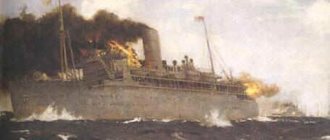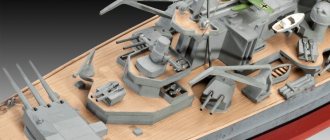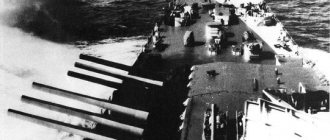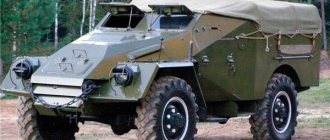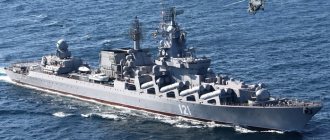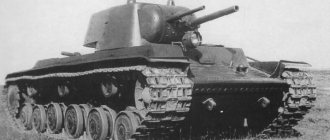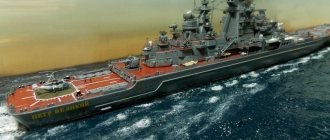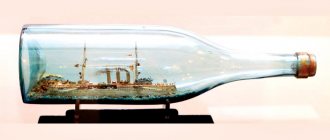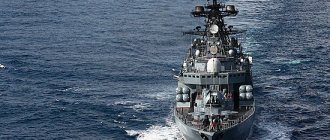Fuhrer's pride
Despite the fact that the cruiser "Scharnhorst" was considered one of the best, a well-armed, high-speed cruiser from the first days of its existence, the nickname was assigned to it - the floating curse. Troubles with the cruiser began long before it was launched. One day, while building the ship, the unfinished cruiser unexpectedly capsized at the dock. Sixty workers were instantly killed, smeared on the concrete walls of the dock, and another hundred and ten were seriously injured. But that was only the beginning. During the launch of the cruiser, the Fuhrer himself was present at the ceremony. However, instead of a pompous celebration, there was a terrible embarrassment. Planned to be the fastest cruiser armed with the latest technology, it fell off the slipway, crushing two barges with its mass. Troubles continued during the fighting. In one of the first battles, during the shelling of Danzig, the Scharnhorst's bow gun exploded. Nine sailors were killed and another nine were wounded. The next day, the air duct of the turret of one of the guns failed. Twelve more crew members said goodbye to life from suffocation. The history of the German naval forces has never known such an unlucky ship. Moreover, during several battles, the Scharnhorst, despite its firepower, was unable to sink a single enemy ship. During the shelling of Oslo, the cruiser was damaged by a torpedo, and the sailors began to seriously talk about the fact that their ship was cursed. At the same time, the ship's troubles continued. While undergoing repairs at the mouth of the Elbe away from the fighting, he nevertheless found trouble again when he collided with the passenger liner Bremen.
Fuhrer's Pirates. The sinking of the battleship Scharnhorst.
Battlecruiser (or is it still a battleship?) Schanghorst.
Total displacement is 39 thousand tons. GBP-350mm, deck-95mm. Max speed is 31.7 knots.
AGK-3x3x280mm,
anti-mine caliber 4x2x150mm, 4x1-150mm.
Air defense artillery:
14-105mm; 16-37mm; 10-20mm.
TA-2x3x533mm
Air group - 3 Arado Ar 196 A-3, one catapult.
There were 2 Gneisenau and Scharnhorst battleships or battlecruisers. For a battleship, their AGK-280mm is rather weak (there were plans to change the AGK to 3x2x380mm). For a battlecruiser, they are too well protected and do not have an overwhelming advantage in speed over new battleships, as was the case during WWI (where the difference in speed reached 8 knots).
Scharnhorst at sea.
Prince of Wales. Duke of York sister ship. One project.
Total displacement 45 thousand tons. The GBP varied not only in length, but also in height, amounting to 152 mm along the lower edge, 356 mm along the waterline and 330 mm along the upper edge in the area of the main caliber (GK) cellars, and in the area of the EC, 127, 330 and 305 mm, respectively.
AGK-2x4x356mm. 1x2x356mm. Anti-mine artillery - 8x2x133mm. Air defense Oerlikon-1x18, Bofors-20x2x.
KRL Belfast. Standard English light cruiser.
AGK4x3x152 mm. speed 33 knots, displacement 13 thousand tons.
Light cruiser Jamaica (Crown Colony series) - well, basically a smaller version of Belfast. Total displacement - 11 thousand. tons with the same AGK and speed.
In the second half of 1943, the position of the German army in Russia became critical. Since the threat from the German squadron had significantly diminished, the British Admiralty, yielding to the persistent demands of its Russian allies, agreed to resume convoy escort to Murmansk and Arkhangelsk. Remembering the sad experience of 1942, the British abandoned large convoys of 40 ships and began to divide them in two. The new cycle began on November 1 with the departure of 13 empty ships (RA-54A) from Arkhangelsk, and in a month and a half it was possible to conduct three eastern convoys (JW-54A, JW-54B, JW-55A) and two western (RA-54A and RA) without losses. -54B). The convoys were accompanied by a traveling escort of destroyers, frigates and corvettes, which was joined by a local escort at the final stages of the route. In the most dangerous sector - south of Bear Island - they were accompanied by a close cover of cruisers, and a long-range cover, which included a battleship, patrolled from 10 miles to the east to 200 miles to the north-west of the island, covering both convoys at once, which met as times in this area.
The Germans discovered convoy JW-55A, but did not attack, and all 19 ships safely reached the Kola Bay and Arkhangelsk. However, on December 19-20, at a meeting with Hitler, the commander-in-chief of the fleet, Admiral Dönitz, announced that Scharnhorst and the 4th flotilla would attack the next convoy. After two days of discussion, Hitler authorized the operation, giving the surface ships one last chance to prove themselves. The temporary commander of the strike force, Rear Admiral Erich Bey (in fact, he commanded the destroyers and in this operation replaced the absent Admiral Kümmetz) on December 22 received an order from Grand Admiral Karl Dönitz to switch to three-hour readiness. For the commander of the Scharnhorst, Captain Fritz Hintze, this was his first time at sea in his new position.
Convoy JW-55B of nineteen transports and tankers left Loch Ew on December 20, guarded by 10 destroyers, 4 corvettes and 3 minesweepers. Convoy RA-55A came out to meet him, which was escorted by 10 destroyers, 3 corvettes and a minesweeper. In the Barents Sea, both convoys were covered by Formation 1, consisting of the cruisers of the 10th squadron of Vice Admiral R. Burnet: the flagship Belfast, Sheffield and the heavy Norfolk. Force 2, consisting of the battleship Duke of York (the flag of the commander of the Home Fleet, Admiral Bruce Fraser), the cruiser Jamaica and 4 destroyers was supposed to cover JW-55B from 27° to 38° E, and then return to Scapa. Flow, covering the RA-55A. On December 22, 400 miles west of the Norwegian port of Tromso, the JW-55B convoy was discovered by German aircraft. The commander of the North group, Admiral Schniewindt, at first decided that a landing in Norway was being prepared, but the panic soon subsided. Two days later, the convoy was again discovered north of Norway and it was determined that it was heading to the USSR. On Christmas Day, December 25, at about 9.00, the German submarine U-601 reported the exact coordinates of the convoy and Admiral Dönitz ordered to intercept. His order to Admiral Bey contained the following:
“The operation can be interrupted at your discretion. In principle, you must interrupt the battle if superior enemy forces appear. A tactical situation must be exploited with skill and audacity. The fight shouldn't end in stalemate. Every opportunity to attack should be taken. The Scharnhorst's superior gun power offers the best chance of success, and it must be taken advantage of. Destroyers should be used later. Inform crews accordingly. I have full confidence in your offensive spirit."
The order was contradictory, as it convinced Bey to attack in any case, but also demanded that the battle be interrupted when a stronger enemy appeared. Admiral Bey planned to attack the convoy at about 10 a.m. on December 26, if the weather and visibility were favorable and information about enemy forces was correct. With only six hours of darkness and only 45 minutes of daylight, the battle had to be fought very quickly.
The German formation (Scharnhorst, destroyers Z-29, Z-30, Z-33, Z-34, Z-38) went to sea at about 19:00, and at 23:00 the Norwegian coast disappeared over the horizon. Admiral Bey maintained constant contact with the headquarters of the naval group "North" and at 3.19 the fleet command conveyed to him the decision of the German Admiralty on the return of the destroyers in case of worsening weather and on the action of the Scharnhorst alone. The British were able to intercept and decipher this message, and when Bey read the new order, the British admirals Burnet and Fraser were already holding its English translation in their hands. At 7.03 on December 26, a German formation, located 40 miles southwest of the island. Bear, turned to the point where in the morning twilight - about 10 o'clock - according to calculations, a meeting with the convoy was supposed to take place. The destroyers were searching 10 miles southwest of Scharnhorst, the crews were in a state of full combat readiness from 03.00. In the stormy sea the destroyers had a hard time and their speed had to be reduced to 10 knots.
At a long-range cover formation that left Iceland on December 23, located 270 miles west of the North Cape, Admiral Fraser received an Ultra interception that the Scharnhorst was rushing towards the convoy. British intelligence was able to decipher the order - “East Front (17.00). “Scharnhorst” will go to sea on the 25th at 17 o’clock,” and Admiral Fraser was asked to prepare for action to cut off the German battleship’s path back to Norway. By 0925, Fraser's ships were 125 miles southwest of Scharnhorst, and Admiral Burnet was informed of Fraser's plans and the contents of the Ultra decryption. Admiral Fraser ordered the 36th destroyer division from the escort of convoy RA-55A, which was prudently sent north of the intended battle area, to join convoy JW-55B (the main target of the Scharnhorst). Vice Admiral Burnet positioned his formation between the convoy and the possible direction of the Scharnhorst's appearance. The commander of the Soviet Northern Fleet, Admiral A. Golovko, ordered the submarines L-20, K-21 and S-102 to go to the North Cape area and intercept the German raider. At the same time, the destroyers at the base were warming up the turbines, and the planes at the airfields were armed with torpedoes and bombs.
When the Belfast radar detected the Scharnhorst at 8.40 on December 26 from a distance of 33,000 m at a bearing of 295°, a combat alarm was sounded on the close-cover ships. The German raider at this moment was approximately 32 miles from the convoy, and three British cruisers began to approach the enemy. The Scharnhorst did not yet suspect the presence of British ships, since for greater secrecy it did not turn on its radar. At 9.21, the signalmen of the cruiser Sheffield spotted a German ship from a distance of 11,000 m at a bearing of 222°, and three minutes later the Belfast opened fire with illuminating shells from a distance of 8,600 m. At 9.25, the first salvo from the cruiser Norfolk landed just 500 meters from the side of the Scharnhorst, which responded with a salvo from the Caesar turret, and then began to retreat at 30 knots. "Belfast" and "Sheffield" used flameless gunpowder, and "Norfolk" used an older gunpowder that gave strong unmasking flashes. The British used artillery radars and in this they were superior to the enemy, who had an advantage in speed and gun power. During the 20-minute firefight, the Scharnhorst was hit by three 203 mm shells. The first hit the upper deck from the port side between the deck 150-mm installation and the torpedo tube and, without exploding, went into the cockpit of the watertight compartment IX. A small fire that started there was quickly extinguished. Another shell a few minutes later hit the bow rangefinders and showered the anti-aircraft artillery staff with shrapnel. It destroyed the bow radar antenna, and fragments penetrated into the cabin of the receiving radar station, killing all the personnel there. The ship was “blind” from the bow angles, approximately 69-80°, since the stern radar, located below the bow, had a limited forward angle. The third shell hit the forecastle and exploded in the cockpit.
Trying to get out of the battle, Scharnhorst changed course several times. At 9.55 Admiral Bey radioed about the battle with the British cruisers, but a few minutes later he was able to break away from the enemy, who in the stormy sea could not give more than 24 knots. Having an advantage of 4 - 6 knots, the Scharnhorst quickly increased the distance from its pursuers. At 10.30 the 36th Division joined Burnet's cruisers, forming a wake column to port and forward of Belfast.
Breaking away from the cruisers, Scharnhorst again began searching for the convoy and by 12 o'clock reached the northeast of it. Five minutes later, Belfast restored radar contact with the Germans, but only at 12.21 were the British cruisers able to close the distance. At this moment, Scharnhorst detected them with its stern radar, and then visually. The British fired flare shells, but the battlecruiser quickly opened fire from the bow turrets and again changed course to the northwest, bringing the stern turret into the battle. This turn prevented the British destroyers from launching a torpedo attack. Three salvos hit the end ship of the 36th division, Virago, which had just passed under the nose of the cruisers.
At 12.23 "Norfolk" was hit in the area of the stern pipe. A few seconds later, a second 283 mm shell struck the barbette of his "X" turret, putting it out of action. To prevent the cellar from exploding, the towers had to be flooded. The first hit turned out to be more serious. The shell pierced the superstructure on the starboard side and exploded right next to the left side skin, tearing it apart over a large area. The fragments completely disabled the radar installation, after which the cruiser could not maintain accurate fire. There were 7 killed (1 officer) and 5 wounded. Tower "B" fired 4 more salvos using the old data, and then "Norfolk" temporarily ceased fire. A few minutes later, Sheffield was bombarded with a hail of large fragments. An erroneous order from his artillery officer sharply reduced the intensity of fire - instead of firing with the whole side, the cruiser switched to turret fire. At 12.41, when the situation began to turn out badly for the British - after all, Scharnhorst was much stronger than the three cruisers, Admiral Bey changed course and increased speed. He did not want to continue the unpleasant battle with the cruisers; his goal was the convoy. After the end of this phase of the battle, Admiral Fraser's ships approached from the southwest, and Burnet's cruisers continued to stay outside the Scharnhorst's fire, maintaining radar contact and reporting the enemy's coordinates to their battleship.
The German destroyers saw the illumination shells that the British cruisers fired in the morning battle, but they were far from the Scharnhorst. Admiral Bey ordered them to go northeast to join the flagship, but at 11.58 sent them west again to search for the convoy. After this, there was no longer any tactical interaction between the Scharnhorst and the German destroyers. At about 1 p.m., the destroyers, unknowingly, passed only 15,000 m south of the convoy. Finally, at 1:43 p.m., Admiral Bey ordered them to stop searching and return to base. The next day at about 10.00 they returned to Kaa Fiord. Their absence in the final phase of the battle at the North Cape turned out to be fatal for Scharnhorst. After all, if its bow radar failed, the destroyers could detect the enemy in a timely manner, help the flagship repel torpedo attacks, and they themselves would pose a serious danger to British ships, having 150-mm guns and 8 torpedo tubes.
The eldest of the surviving members of the Scharnhorst crew, non-commissioned officer Willy Godde, who was on the bridge according to the combat schedule, described the battle with the cruisers as follows: “Shortly after 12.30, I and some others noticed the shadows of three ships ahead, which was immediately reported to the commander. The alarm had already been announced because the enemy had been detected by radar a little earlier. However, before our guns opened fire, illumination shells exploded above the Scharnhorst. The enemy's volley fell very close. But our first salvo from 28-cm guns also pinned the enemy down. I saw that after three or four salvoes a strong fire started on one of the cruisers in the area of the stern tube, the other cruiser began to burn strongly in the bow and stern and was enveloped in thick smoke. After the next salvos, I saw hits in the bow of the third cruiser. At one point, a huge tongue of flame shot up into the sky, which then disappeared. Observing thick smoke around the cruiser, I assumed that it was burning heavily. The enemy's fire began to weaken, and when we changed course, the enemy cruisers turned away and disappeared behind the rain and snow squalls. During this battle the enemy was in front on both sides. These cruisers were fired at by our Anton and Bruno turrets, which were occasionally joined by two bow 150-mm turrets. I did not hear, either on the phone or in any other way, about any hits against us in this phase of the battle. Although the enemy was barely visible during the first contact, this time, in the daylight, we could easily determine that they were cruisers. The distance was also shorter than in the morning battle.”
At about 1:15 p.m., Admiral Bey decided to return to base, not expecting any more skirmishes. The ship's crew, not fed since the morning, started lunch, but combat readiness remained. The stern radar was turned off so as not to be detected by its operation. At 15.25 Bey radioed the North Group headquarters with his estimated time of return. He did not know that he was going right to the intersection of the course of the Duke of York, the Jamaica and four destroyers, which were being radioed by the cruisers. With the bow radar destroyed and the stern one turned off, and also unable to search directly ahead, the Scharnhorst walked straight into a trap from which there was no way out. 75 kbt behind (with visibility at 70), like a pack of hounds, in front formation, closed so as not to clog the screens of their radars with unnecessary marks, were Burnet's cruisers and the 36th division. This peculiar “rut” lasted more than three hours. There was a moment at the beginning of five o'clock in the afternoon when the situation could change. The Norfolk reduced speed to put out the fire, and 7 minutes later the Sheffield slowed down to 8 knots, on which the bracket of the left inner propeller shaft broke. But already at 16.17 the search radar of the British battleship detected the enemy at a distance of 225 kbt. The death warrant for Scharnhorst was signed. Fraser ordered to continue tracking until the ships came within effective fire range.
At 16.32, the Type 284 artillery radar on the Duke of York found a target at 147 kbt (27,200 m) and 11 minutes later Fraser ordered Belfast, Burnet's only cruiser that could join the battle, to open fire with illumination shells, and his destroyers - be ready for a torpedo attack at the admiral's signal. "Duke of York" and "Jamaica" set course 80 to use the stern towers. The German ship was sandwiched between Formations 1 and 2.
When at 16.47 the shells of the first salvo exploded in the sky, the British were surprised to find that the main caliber turrets on the Scharnhorst were deployed to the stowed position. A minute later, the Duke of York opened fire with 133-mm illumination shells, and two minutes later began firing in salvoes from a distance of 11,000 m. At 16.52, the cruiser Jamaica joined it from a distance of 12,000 m, achieving coverage with a third salvo (one hit ). Although Scharnhorst was taken by surprise, after the explosion of illumination shells, she quickly returned fire and, without hesitating a moment, turned north. The duel between him and the battleship Duke of York was unequal - German 283-mm shells could not penetrate the thick armor that protected the vital parts of the English battleship. At 16.55, a 356-mm shell from the first salvo hit the starboard side of the Scharnhorst opposite the Anton tower. The turret was jammed with the guns raised, and the horizontal and vertical aiming drives were out of order. A fire started in the cellars from hot fragments, and the fragments also pierced the flameproof door to the cellars of the Bruno tower. The cellars of both towers had to be flooded, but under the Bruno tower they were drained so quickly that this had almost no effect on its rate of fire. The supply servants worked waist-deep in icy water, trying to save at least part of the ammunition. Despite the damage, the ship maintained high speed. The second shell damaged the ventilation duct of the Bruno turret, which is why its fighting compartment was filled with gases and smoke after each opening of the gun lock. Another shell hit near the Caesar turret and punched a hole 0.5 m in diameter in the battery deck. The hole was quickly repaired, but the compartments where the shell exploded were flooded with water and not drained. Two planes were riddled with shrapnel, several anti-aircraft guns were destroyed, and most of their personnel were destroyed. After this, Captain zur See Hintze ordered the survivors to take cover.
These hits have not yet posed a danger to the Scharnhorst. The main thing is that he maintained his advantage in speed and began to break away from the enemy. Only the destroyer Savage was able to follow him, which the Germans could not throw off the tail, although the shells fell only 20 meters from it. The destroyer came so close that it was forced to turn away without receiving the order to launch a torpedo attack. Having come under fire from Belfast and Norfolk, Scharnhorst turned east and quickly increased its range at a 30-knot speed. Fraser ordered the destroyers to attack, but they could not get close to the target. "Savage" and "Somarets" were kept to the left rear, and "Stord" and "Scorpion" were to the right rear of the pursued enemy. At 17.42, due to the increased distance, the Jamaica ceased fire, and only Fraser’s flagship continued to methodically fire salvos at the retreating Scharnhorst.
Fortunately for the British, the Duke of York's shooting was accurate. One after another, gun turrets came out on the German ship; fragments of heavy shells even penetrated into the cellars, knocking out the servants working in the supply. And at about 18.00, a shell hit the starboard side, piercing the thin belt of the upper citadel (45 mm) and the battery deck, ricocheting along the 80-mm lower armored deck, piercing the glacis of the same thickness above boiler room No. 1, exploding in the latter. On the ship at first it seemed like it was a torpedo hit - the impact and explosion were so strong. Numerous steam pipes of four boilers located in this department were torn apart. Shell fragments pierced the double bottom, causing the compartment to flood to the floor level. The ship's speed dropped to 8 knots. Emergency measures were taken quickly and effectively, but with the watertight doors and hatches closed
25 people were locked in the boiler room. The steam pressure was increased, and the chief engineer, frigate captain Otto König, reported to the bridge: “I can make 22 knots,” to which the ship’s commander, Hintze, replied: “Bravo, hold it!” "Scharnhorst" fired from a distance of 15,000 - 20,000 m and covered the "Duke of York" with several salvos, the side of which was covered with fragments, and with a direct hit on the foremast, one of its supports was blown overboard and temporarily disabled an artillery radar of the type 284. Lieutenant Bates, who climbed the mast, managed to repair the broken cable between the antenna and the radar screen, and the fire was able to continue with the same efficiency. The rest of the damage on the English battleship was caused by its own fire: demolished ventilation fungi, damaged deck, broken boats.
The artillery duel lasted almost 90 minutes, and the Scharnhorst received significant damage. Its superstructures were pierced in many places by shrapnel, and in some places destroyed by direct hits from 152 mm, 203 mm and 356 mm shells. Fires started, sometimes accompanied by explosions. Under these conditions, the crew continued to do their job skillfully and calmly. The fire in the hangar, which destroyed two seaplanes, was extinguished within 10 minutes, but an attempt to launch the remaining aircraft from a catapult failed because it destroyed compressed air supplies. Almost all artillery installations and torpedo tubes on the left side were destroyed or disabled. The surviving servants were ordered to take cover and fight the fires. At 17.30, 356-mm shells hit both bow 150-mm turrets: the right one was completely destroyed, killing all the people in the turret and on the feed, and the left one was jammed. But after 10 minutes it completely failed.
The torpedo officer, under hurricane fire, bravely rushed to the port side torpedo tube even before the latter was disabled. He was able to deploy the device and fired two torpedoes, and the third got jammed in the pipe. According to eyewitnesses, this officer was killed by fragments of a shell that exploded nearby or by a shell that hit a jammed torpedo, which detonated in the apparatus. The shell that hit the forecastle broke the chain of the right anchor, which fell into the sea with the remains of the chain. Soon the same thing happened with the bow anchor.
Rear Admiral Bey now knew for sure that he was driven into a corner and at 18.24 he ordered the last radiogram to be sent to Hitler: “We will fight until the last shell.”
At 18.42, the Duke of York ceased fire, firing 52 salvoes, of which 31 were covered and scored at least 13 direct hits. These shells and shells from cruisers killed and wounded a large number of people on board the Scharnhorst and disabled almost all of the 150-mm guns. However, Scharnhorst was still maintaining high speed, and Admiral Fraser, fearing that the enemy would escape, ordered the destroyers to launch a torpedo attack.
Thanks to the drop in Scharnhorst's speed, the S-class destroyers from Force 2 managed to get within 60 cables of it. The German ship no longer had the means to repel such attacks, which allowed the destroyers to approach torpedo salvo range almost without opposition. At about 18.50, “Stord” and “Scorpion” on the right circulation, being on both sides of their victim, fired 8 torpedoes each from a distance of 1650 and 1900 m. “Scharnhorst” turned sharply to the right, but three torpedoes still reached the target. With this turn, he exposed the side of the destroyers Savage and Somarets. The first fired eight torpedoes, and the second, approaching 1600 m, came under fire from the few surviving small guns on the starboard side and one main gun turret of the German ship. The shells pierced the director and rangefinder on the destroyer, shrapnel riddled the side and superstructures, and its speed dropped to 10 knots. An officer and 10 sailors were killed on the ship, 11 people were wounded. Somehow they recruited people to crew one torpedo tube, but the second one was still destroyed. Having fired four torpedoes, the Somarets turned away, laying a smoke screen. They even set fire to the smoke buoy at the stern, after which the crew, deciding that the destroyer was on fire, flooded the stern cellars.
Damage from torpedoes . Available information on torpedo damage is very sketchy. One torpedo exploded on the starboard side opposite the Bruno turret, jamming the horizontal and vertical guidance drives in it, as well as the main entrance hatch, so that the servants could not get out onto the deck for a long time. The cellars began to flood. Another torpedo hit the port side boiler room area and caused some flooding behind the torpedo bulkhead. The third hit the stern from the left side in the place where several compartments were already flooded, and damaged the propeller shaft. The fourth torpedo hit the bow from the same side. All torpedoes had a 340 kg charge.
Analyzing the damage to the Scharnhorst and Gneisenau from torpedoes in previous battles, we can confidently assume that in this case there was significant flooding of internal volumes. Obviously, a torpedo hit in the area of the Bruno tower was very dangerous. It caused not only a powerful blow, but also destroyed the PTZ, leading to huge flooding. The underwater defense system in this place was especially vulnerable, not having sufficient width due to the sharp contours of the hull. The 340-kg charge of a British torpedo was enough to destroy the protection in the area of the boiler room. The damage there would have been more significant if the layer of empty compartments in the torpedo protection system, which absorbed most of the flooding, had been filled with water.
As a result of torpedo hits, the Scharnhorst's speed dropped to 12 knots, although the chief engineer reported that he was ready to maintain 22 knots. The Duke of York was able to get closer again, now at a “pistol” distance of 9100 m for 356-mm shells. The final execution of the German ship began, which could not even adequately respond: two of its bow turrets were jammed, and the third was experiencing a shortage of shells. All available crew members (probably servants of the 105 mm guns) worked on transferring ammunition from the Bruno turret magazines to the Caesar turret, which resumed fire a few minutes later.
As the hull filled with water, the Scharnhorst's speed dropped to 5 knots and it almost did not obey the rudder. Even after the battle with the Bismarck, the British realized that it was impossible to sink a large German ship with artillery alone. Therefore, Admiral Fraser ordered the cruisers to finish off the Scharnhorst with torpedoes.
At 19.25, the Jamaica, which had previously fired 22 broadside salvos at the enemy, fired two torpedoes from the left tube (the third tube turned out to be faulty). Two minutes later, Belfast released three more. Then the Jamaica turned around and, approaching 3500 m, 10 minutes later fired three torpedoes from the other side. The hits were impossible to distinguish due to smoke and fog. The cruisers left the battle arena, into which the destroyers of the 36th division entered. The Musketeer, having passed 900 m from the Scharnhorst crawling at 3 knots, fired 4 torpedoes on the starboard side at 19.33 and saw three explosions between the funnel and the mainmast. A minute later, Matchless tried to do this, but a huge wave, covering the ship, damaged the aiming mechanisms of the devices. The second wave, which flooded the bridge, disabled the in-ship communication devices, so the order to turn the devices to the right did not reach the torpedo officer. Matchless had to return to attack on the port side. "Opportune" discharged one apparatus 19.31 from a distance of 1900 m, the other - two minutes later from 2300 m, and its observers clearly saw one hit from each salvo on the starboard side of the battle cruiser between the mainmast and the chimney. The effect of their explosion was insignificant, since the Scharnhorst was already deep in the water, and the torpedoes hit the main armor belt. At 19.34, the Virago fired seven torpedoes from a distance of 2500 m, also claiming two hits. After these attacks, the German ship practically stopped, enveloped in thick smoke and steam. Little could be seen from the English ships - a dim glow could be seen and dull explosions could be heard. The veil of smoke was so dense that neither searchlight beams nor flares could pierce it.
At about 7 p.m., the Scharnhorst commander ordered all secret documents to be burned. Since all the other guns were already silent, he told the servants of the 150-mm turret No. 4: “... it all depends on you.” The ship heeled to starboard and sank nose-first. The last turret of 150 mm guns fired until its ammunition lift jammed. The 20mm gun on the roof of the Bruno turret continued to fire. By 19.40 the roll had increased greatly, and the bow almost went under water. All hatches and watertight doors were reinforced to contain flooding and give the crew more time to escape. However, torpedo damage deprived the ship of most of its buoyancy reserve. At 19.45 "Scharnhorst" nose went under the water with slowly rotating propellers. For some time a strong roar could be heard from under the water. The British recorded a strong explosion before the flooding, attributing it to the cellars. Belfast intended to carry out a second torpedo attack at 19.48, but the target was lost. “Match-less” also did not find “Scharnhorst” and, together with “Scorpio”, began to pick up people floundering in the icy water. Until 20.40, the destroyers Belfast and Norfolk were looking for survivors. "Scorpio" picked up 30 people, and at one time the ship's commander Hintze and the senior officer of the frigate captain F. Dominic were seen from it. But Hintze died before help arrived, and Dominic, although he managed to grab the thrown line, was unable to climb it to the deck; he was picked up already dead. Of the 1968 crew, only 36 were saved.
When sinking the Scharnhorst, the British expended 446 356 mm shells, 161 203 mm, 974 152 mm, 531 133 mm (plus 155 lighting) and 83 102 mm, as well as 55 torpedoes, of which 11 hit the target: “Jamaica” and “Virago” scored 2 hits each, “Masketeer” and “Savage” scored 3 each, and “Scorpio” scored 1 hit. When shooting with large caliber, there were some difficulties with equipment failure. Because of this, for example, in the bow turret of the Duke of York, with 77 salvoes given, one gun fired 71 shells, and the rest 47, 6 (!) and 64.
Admiral Fraser was amazed at the heroic actions of the German crew. On the return passage to Scapa Flow from Murmansk, when the Duke of York passed the site of the death of the Scharnhorst, he ordered a wreath to be thrown into the water in memory of the German sailors who had fulfilled their military duty.
The Germans themselves explained the death of the Scharnhorst by the lack of escort destroyers and the superiority of British radars. After the war, Admiral Karl Dönitz wrote: “... The operation undertaken by the battlecruiser Scharnhorst and a group of destroyers in December, after a successful covert start, seemed to have every chance of success, given the enemy’s deployment and weather conditions. But it failed, obviously due to an underestimation of the local situation, and Scharnhorst was lost..."
As we now know, the operation did not have a hidden beginning, since Ultra deciphered the German codes. The commanders of both British battle groups were reasonably well informed about the planned movements of the Scharnhorst and, under such conditions, could prepare their response.
One way or another, Scharnhorst became the last Kriegsmarine ship to take offensive action. His death put an end to the threat posed by the German surface fleet and seriously undermined Germany's position in Norway.
The end of Gneisenau is less sad, but still significant.
On the night of February 27, 1942, the Gneisenau, which had just arrived in Kiel, was hit by a British 454-kg armor-piercing bomb in the area of the first turret. The explosion caused enormous destruction and fire (230 main-caliber powder charges ignited at once). 112 sailors were killed and 21 wounded. The battleship was towed to Gotenhafen (Gdynia) for repairs. During the latter, by the way, it was planned to replace the main artillery with six 380-mm guns. Alas, these plans remained on paper. In January 1943, all work was stopped.
On March 23, 1945, the skeleton of the Gneisenau was flooded in order to block the entrance fairway.
Py.sy. The shameful death of the pride of the Reich, the death of 1,467 crew members, infuriated Hitler. Furiously, he blurted out: “There is no need for any mourning events! This is the lot of traitors who are unworthy to be Aryans!”
All the same, Adolf Alozievich was a rare bitch.
The death of the damned cruiser
It is not surprising that the premature death of the ship turned out to be no less dramatic and at the same time stupid, like its entire existence. While patrolling the North Atlantic, the cruiser did not see an English patrol boat in thick fog. The Scharnhorst locators also missed the danger. In vain. The boat disappeared into the fog, and then returned with an entire squadron of English patrolmen. The cruiser, when she saw that she had fallen into a trap, fled instead of taking the fight, but was overtaken by a whole “flock” of British torpedoes and sank. The ship's entire crew of 1,460 people went to the bottom. Only 36 sailors from the ill-fated cruiser survived.
